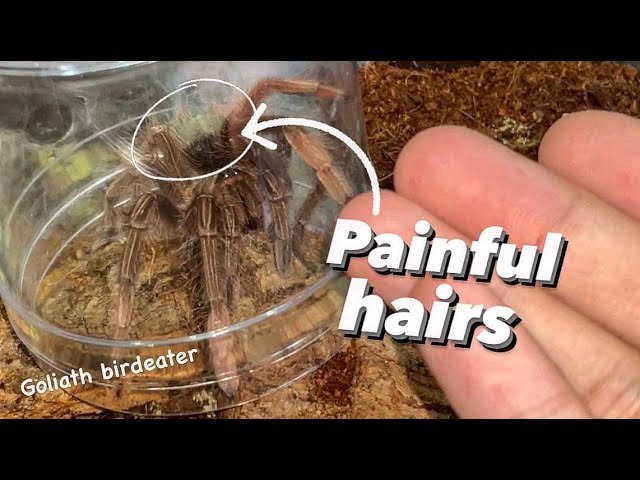I never expected to encounter such an excruciating experience, but these TARANTULA HAIRS have proven to be far from just an annoyance. Rather than simply being itchy, they unleash a level of pain that is beyond comprehension! Let me share my harrowing encounter with these peculiar creatures and the agony they inflicted upon me.
Introduction
I have always been fascinated with exotic pets, and one of my latest endeavors is keeping Theraphosa apophysis, also known as Goliath Pink Foot Bird Eater tarantulas. These massive creatures are not for the faint of heart, but they are truly captivating to observe. However, as they grew larger, it became evident that they needed to be rehoused. In this article, I will share my experience of rehousing three of these magnificent spiders and the unexpected challenge of dealing with their painful hairs.
Rehousing the Tarantulas
-
Preparing for the Rehousing
- When I noticed that my tarantulas had outgrown their enclosures and were starting to show signs of distress due to mushroom spores, I knew it was time to rehouse them.
- I decided to use temporary enclosures made of coconut fiber, which provides a natural environment for these arachnids. I also added broken pots for hiding spots.
-
The First Female Tarantula
- Rehousing a tarantula can be a delicate process, especially with their aggressive nature. To minimize any potential harm, I used a cup to gently transfer the first female tarantula into her new enclosure.
- I was relieved to see that the process went smoothly, and she seemed content in her fresh surroundings.
-
The Second Female Tarantula
- As I approached the rehousing of the second female tarantula, I knew that her aggressive tendencies may pose a challenge. However, I was determined to proceed with caution.
- To my surprise, she not only displayed aggression but also started kicking her hairs, which can be irritating to humans. I couldn’t help but feel itchy just being in close proximity to her.
-
The Feisty Male Tarantula
- The final tarantula to be rehoused was the male, who was noticeably larger than the females. I knew I had to tread carefully, as he could potentially inflict more harm with his venomous bite.
- As expected, he too kicked his hairs to display his displeasure. However, with patience and a steady hand, I successfully transferred him into his new enclosure.
These TARANTULA HAIRS aren’t even itchy – THEY’RE PAINFUL !!!
The moment I discovered firsthand the true nature of tarantula hairs, I realized that they were an altogether different experience from itchiness. These tiny, barbed hairs are known as urticating hairs and are a tarantula’s primary line of defense. When disturbed, these hairs are flicked off the tarantula’s abdomen and can cause significant pain and irritation when they come into contact with the skin or eyes.
The sensation is far from a run-of-the-mill itch. It’s an intense sting that lingers, almost as if the hairs are embedded in the skin. The barbed nature of the hairs allows them to penetrate the skin and attach themselves firmly. Once embedded, it can take days or even weeks for the pain and irritation to subside.
The level of pain experienced can vary depending on an individual’s sensitivity and the species of tarantula. However, it’s important to note that these hairs can cause serious discomfort, especially if they make contact with sensitive areas such as the eyes or mouth.
FAQs After The Conclusion
-
Q: Are all tarantula hairs painful?
- A: Not all tarantula species possess urticating hairs, but those that do can cause varying degrees of pain and irritation.
-
Q: How can I protect myself from tarantula hairs?
- A: It is recommended to wear protective clothing, gloves, and goggles when handling tarantulas or working within their vicinity.
-
Q: Can tarantula hairs cause long-term damage?
- A: While the effects of tarantula hairs are primarily temporary, it is possible for them to cause long-lasting irritation or allergic reactions in some individuals.
-
Q: Can I remove tarantula hairs from my skin at home?
- A: It is best to seek medical assistance if tarantula hairs become embedded in the skin or eyes, as improper removal may exacerbate the situation.
-
Q: Are there any precautions I should take when rehousing tarantulas?
- A: It is advisable to wear protective gear, handle tarantulas with caution, and be prepared for the possibility of encountering their painful hairs.
In conclusion, the process of rehousing my Theraphosa apophysis tarantulas was not without its challenges. These magnificent creatures, while awe-inspiring, can unleash tiny hairs that cause more pain than a simple itch. It is essential to approach rehousing tarantulas with caution, ensuring the safety and well-being of both the spiders and the individuals handling them.
